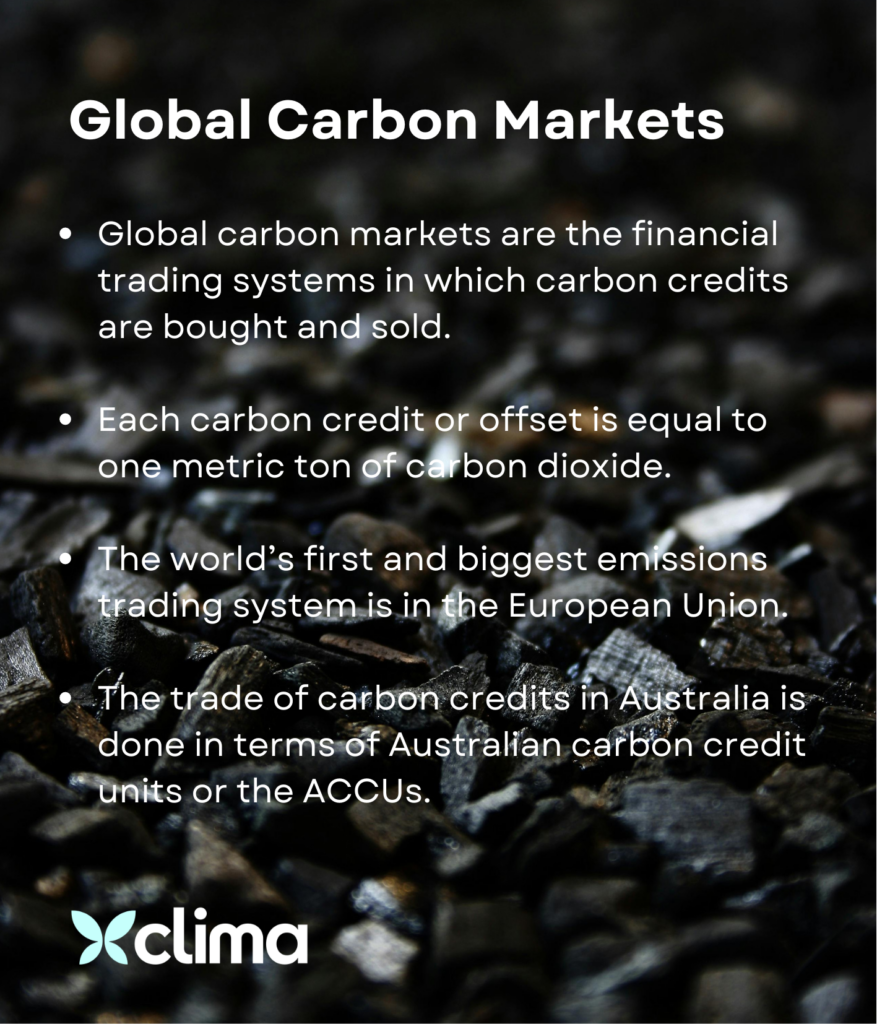Key Points
- Global carbon markets are the financial trading systems in which carbon credits are bought and sold.
- Each carbon credit or offset is equal to one metric ton of carbon dioxide.
- The world’s first and biggest emissions trading system is in the European Union.
- The trade of carbon credits in Australia is done in terms of Australian carbon credit units or the ACCUs.
Table of Contents
What Are the Global Carbon Markets?
Global carbon markets are the financial trading systems in which carbon credits are bought and sold. Each carbon credit represents a set amount of emissions that the owner of the said credit can emit. These emissions can be carbon dioxide or any sort of greenhouse gas that may have a negative impact on the environment. Each carbon credit or offset is equal to one metric ton of carbon dioxide. The markets can be run by the government or privately and the buyers trade according to their will to comply with the emission regulations put in place.

In a lot of countries, the governments have strict policies on carbon and greenhouse emissions. To comply with these regulations, companies need to be transparent about their emissions and what they are doing to limit them. Here the companies can opt for carbon credits and carbon offsets to help them minimize their carbon footprint. The carbon markets are very versatile and everyone is welcome to trade for example industries, companies, organizations, and individuals.
The terms carbon credits and carbon offsets are used interchangeably but some experts argue that they are two different terms. Carbon credits are mandatory in a few countries for businesses to purchase whereas carbon offsets are voluntary for the businesses to trade in. Today, there are around 30 compliant carbon markets and an unknown number of voluntary carbon markets. The most noteworthy carbon markets or Emission Trading Systems (ETS) belong to the European Union and the People’s Republic of China. Here we discuss each of them:
European Union ETS
The world’s first and biggest emissions trading system is in the European Union and was launched in 2005. This EU ETS covers all of the European Union and a few other countries which include Iceland, Liechtenstein, and Norway. It is believed that the EU ETS market caters to more than 10,000 businesses. The first aim of EU ETS is to reduce net emissions by at least 55% by 2030 compared to 1990.
People’s Republic of China ETS
The PRC launched its own ETS in 2021. It is said to be the largest ETS in the world in terms of covering emissions. Currently, it caters to around 2000 businesses in the power sector but it is set to expand in different sectors. It is estimated to cover around 5 billion tonnes of carbon dioxide emissions which accounts for more than 40% of the country’s carbon emissions.
Australian Carbon Exchange
The trade of carbon credits in Australia is done in terms of Australian carbon credit units or the ACCUs. The Australian National Registry of Emissions Units (ANREU) is an online system that tracks the location and ownership of the ACCUs. Through the ANREU, ACCUs can be issued, traded, transferred, surrendered, and cancelled. The market’s supply and demand determine the value of ACCUs and the price can vary based on demand and how successful ACCU projects are.
FAQs
What Is the Difference Between Carbon Credits and Carbon Offsets?
The terms carbon credits and carbon offsets are used interchangeably but some experts argue that they are two different terms. Carbon credits are mandatory in a few countries for businesses to purchase whereas carbon offsets are voluntary for the businesses to trade in. You can buy carbon credits and carbon offsets to fulfill compliance and also if you voluntarily want to do good for the planet.
Why Is it Important to Decrease Carbon Emissions?
It is important to decrease the carbon emissions in the atmosphere because if they keep increasing at the current rate, the temperature of our planet may reach an all-time high which would make our living very difficult and unsustainable. Carbon emissions are the leading cause of greenhouse gases that cause the rise in global temperatures. So decreasing carbon emissions will help us decrease greenhouse gases in the atmosphere which will result in decreased global warming. Having said that, this process will take time and effort.
Conclusion
In conclusion, the global carbon market is a great way for companies to fulfill compliance and also voluntarily invest in green projects to balance their carbon emissions. However, it is a recipe for climate disaster if we only depend on carbon credits and carbon offsets to curb global warming. We need to play an individual part in bringing down emissions and thus global temperatures. This can be done through adopting sustainability development goals (SDGs). However, it is a time-intensive process but we must not lose hope.
Further Readings
- https://www.investopedia.com/carbon-markets-7972128
- https://australiainstitute.org.au/post/carbon-credits-and-offsets-explained/
- https://cer.gov.au/markets/australian-carbon-exchange


